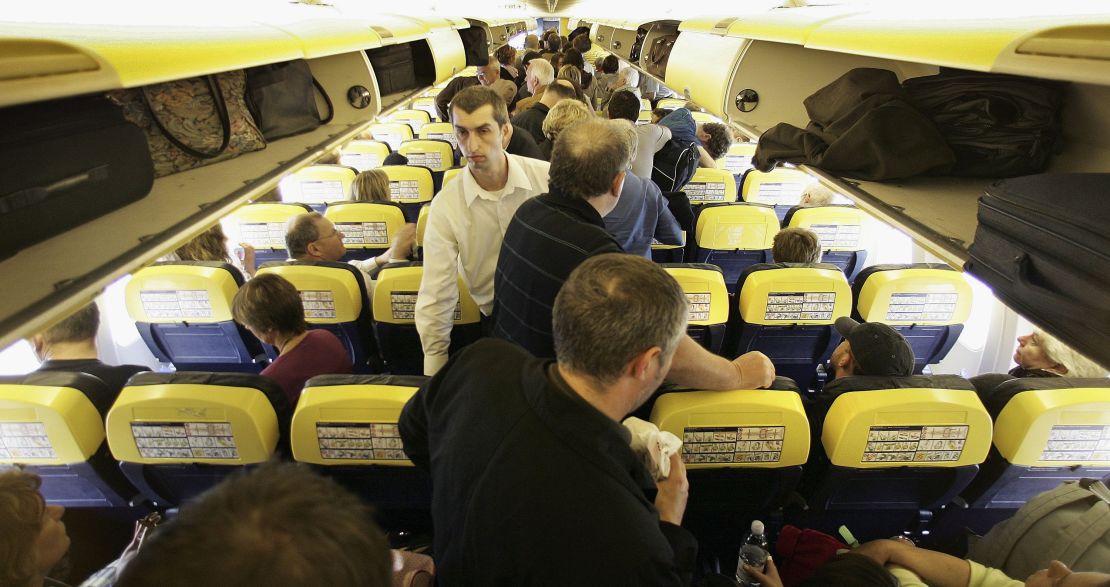Editor’s Note: Cameron Gordon is an Adjunct Associate Professor of Economics and the Centre for Research and Action in Public Health (CeRAPH) (prior to that an Associate Professor of Economics) at the University of Canberra and has an ongoing appointment as a Principal Investigator at the Social Policy Simulation Center at the City University of New York.
Story highlights
Industry research shows that people increasingly dislike airline travel
Consumers especially dislike unbundled pricing because it is complex and easy to game by the airline
Lower prices have created much more demand for air travel, leading to congestion and more delays
Decades ago, airline travel was considered a glamorous and exciting mode of transport, reserved for the rich and elite. Yet while flying has become more democratic and affordable, industry research shows that people increasingly dislike it.
A 2015 survey by the International Air Transport Association (IATA) found people were prepared to queue no more than 10 minutes through security.
More than half wanted to wait no more than 1 to 3 minutes to drop off their luggage.
But the real dissatisfaction began once passengers were onboard, with in-flight service and seat size topping the list of complaints.
What is the source of this dissatisfaction?
The belief that air passengers simply don’t realize how good they have it is growing – and not just among industry advocates, where one would expect it, but also from industry share analysts and some economists.
Since the worldwide deregulation of airlines began four decades ago, the inflation-adjusted cost of air travel has fallen dramatically. Now many more people can afford travel to their favorite destination, whenever they want.
The 20 most rude and annoying things people do on planes
It’s all about perception
Why, then, are consumers such sourpusses?
Lower prices have created much more demand for air travel, leading to congestion and more delays – a byproduct of the industry’s success. Then there are those hated security procedures, another source of delays.
Again, that is outside airline control. The main driver of consumer complaint is misperception.
Taking a leaf from behavioral economics, air travel for most people is infrequent enough that most people don’t realize the true extent of the fall in cost.
Computer prices, for example, have fallen dramatically over the past 40 years and people buy computers enough to notice and appreciate that.
Similar price falls have occurred in air travel, but are less noticed because such travel is generally not as frequent as computer upgrades. Loss of “perks” like meals is much more noticeable and memorable, something behavioral economists refer to as “salience.”
Air rage: 5 ways to avoid losing your temper when flying
Decline in service quality

So should we pity the poor airline, hemmed in by fierce competition on the one side and ungrateful consumers on the other?
Not so fast. For one thing, the price of air travel should be adjusted for quality of service.
Consider computers again. Not only have their prices fallen but they deliver much more than their 1980s predecessors. But passengers not only have lost free meals or toiletry kits. They also now get increasingly less legroom, narrower seats, less reclining seat pitch and less service generally at the gate and on the plane.
Airline vendors continually pitch prototype products, such as seats where one does not fully sit down, and airlines continually test policies, like charging for toilet use on-board – that most human beings would find unpleasant at best.
If people were indeed just like cargo, unit price for distance covered would be a complete metric. But of course they’re not cargo.
Airlines are increasingly using “unbundled” pricing.
Passengers used to pay one price for everything: travel, meals, baggage allowances, in-flight entertainment etc. Now almost all carriers charge separately for everything.
Airline capacity is tightening and companies have more pricing power. Airlines are also using “big data” collected through booking systems for dynamic pricing (or yield/revenue) allowing them to get maximum revenue from each individual passenger by charging the highest price that passenger is willing to pay, or to induce travelers to fill seats that would otherwise go empty.
Airline analysts claim all this is good for the consumer. Big data by definition equals more information, which equals more transparency.
Airfare hacks: 5 ways to fly for less
We might have to fly but we don’t have to like it
Unbundled pricing eliminates “cross-subsidy” of one consumer by another: why should someone with only a carry-on bag, pay the same fare as someone with a full set of checked luggage?
Once more this is a one-sided view.
Consumers especially dislike unbundled pricing because it is complex, easy to game by the service provider, and often leading to unpredictable pricing at the gate.
Most people have been charged an excess baggage fee at the gate, something they were likely not planning on and almost impossible to challenge before embarking.
Consumers like to know what they will be paying but unbundled pricing often turns into “probabilistic” pricing where people pay a certain price only if they don’t cross certain lines.
As for “big data” airlines have much more access to its power than consumers do.
We cannot blame profit-making companies for wanting to squeeze as much out of the consumer as they can subject to competitive pressures.
Passengers are still flying and travel demand is growing, showing that despite service quality declines, they’re still willing to fly and at unit distance prices that are still historically low.
But it hardly seems fair that the consumer should like it.
Is business travel ruining your family life?
9 tips for going the long haul with children
10 packing tips from a travel pro for a best-case scenario
This article was originally published in December 2015.
Republished under a Creative Commons license from The Conversation.
























